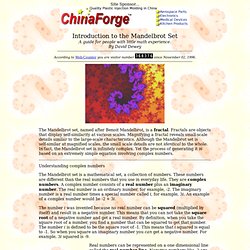

Introduction to the Mandelbrot Set. The Mandelbrot set, named after Benoit Mandelbrot, is a fractal .

Fractals are objects that display self-similarity at various scales. Magnifying a fractal reveals small-scale details similar to the large-scale characteristics. Although the Mandelbrot set is self-similar at magnified scales, the small scale details are not identical to the whole. Understanding complex numbers The Mandelbrot set is a mathematical set, a collection of numbers. Complex numbers . Real number plus an imaginary number . The number was invented because no real number can be squared (multiplied by itself) and result in a negative number. Square root of a negative number and get a real number. Real numbers can be represented on a one dimensional line called the real number line . Since complex numbers have two parts, a real one and an imaginary one, we need a second dimension to graph them. Complex number plane . Graphing the Mandelbrot set We're not really interested in the actual value of as it changes, we just look at its. Fractal Gallery: What Is a Fractal?
[an error occurred while processing this directive] And who is this guy Mandelbrot? Images and text by Alan Beck The word "fractal" was coined less than twenty years ago by one of history's most creative mathematicians, Benoit Mandelbrot, whose seminal work, The Fractal Geometry of Nature, first introduced and explained concepts underlying this new vision.
Although prior mathematical thinkers like Cantor, Hausdorff, Julia, Koch, Peano, Poincare, Richardson, Sierpinski, Weierstrass and others had attained isolated insights of fractal understanding, such ideas were largely ignored until Mandelbrot's genius forged them at a single blow into a gorgeously coherent and fruitful discipline. Lamp (63 k / jpg) Mandelbrot derived the term "fractal" from the Latin verb frangere, meaning to break or fragment. Traditional Euclidean patterns appear simpler as they are magnified; as you home in on one area, the shape looks more and more like a straight line. Serpentes (97 k / jpg) LarvasLeaf (105 k/ jpg) Fractal. A fractal is an object or quantity that displays self-similarity, in a somewhat technical sense, on all scales.

The object need not exhibit exactly the same structure at all scales, but the same "type" of structures must appear on all scales. A plot of the quantity on a log-log graph versus scale then gives a straight line, whose slope is said to be the fractal dimension. The prototypical example for a fractal is the length of a coastline measured with different length rulers. The shorter the ruler, the longer the length measured, a paradox known as the coastline paradox. The Fractory: How Fractals are Generated, Part Two. As of July 1, 2013 ThinkQuest has been discontinued. We would like to thank everyone for being a part of the ThinkQuest global community: Students - For your limitless creativity and innovation, which inspires us all. Teachers - For your passion in guiding students on their quest. Partners - For your unwavering support and evangelism.
Parents - For supporting the use of technology not only as an instrument of learning, but as a means of creating knowledge. We encourage everyone to continue to “Think, Create and Collaborate,” unleashing the power of technology to teach, share, and inspire. Best wishes, The Oracle Education Foundation.